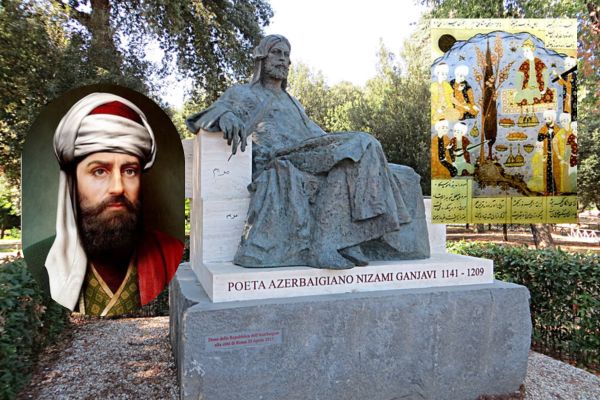Nezami Ganjavi, one of the greatest Persian poets and a luminary in Persian literature, was born in Ganja (in present-day Azerbaijan) around 1141 and lived until 1209. His full name was Jamal ad-Din Abu Muhammad Ilyas ibn Yusuf ibn Zaki, but he is most commonly known simply as Nezami. Renowned for his deeply lyrical and romantic storytelling, Nezami is celebrated primarily for his monumental work, the Khamsa (The Quintet), a collection of five long narrative poems that profoundly influenced Persian and Islamic literature.
Nezami’s life details are sparse, but he likely spent most of his life in Ganja, where he received a comprehensive education in Islamic sciences, Arabic literature, and Persian poetry. He mastered diverse subjects such as philosophy, medicine, and the natural sciences, infusing his poetry with intellectual depth and moral wisdom. Despite several offers from courts across the region, Nezami lived a modest life, choosing literary pursuits over wealth or political power. His focus remained on crafting poetry that would resonate through the ages.
The Khamsa, or "Five Treasures," is his crowning literary achievement, composed of five poetic masterpieces: Makhzan al-Asrar (Treasury of Mysteries), Khosrow and Shirin, Layla and Majnun, Haft Peykar (The Seven Beauties), and Eskandar-nama (The Book of Alexander). Each of these works explores universal themes of love, loyalty, fate, and the human quest for meaning, often through the lens of Persian cultural and moral ideals. Layla and Majnun, a tragic romance, and Khosrow and Shirin, a tale of enduring love, stand out as some of the finest romantic epics in world literature, rivaling even Shakespeare in emotional depth and poetic skill.
Nezami’s work is distinguished by its vivid imagery, philosophical undertones, and profound emotional insight. He developed a unique, refined style known as the "Indian Style" of Persian poetry, characterized by intricate metaphors and rich language, which influenced countless poets after him. His portrayals of women were progressive for his time, celebrating them as intelligent, strong, and morally upright characters, especially in works like Khosrow and Shirin.
Today, Nezami is remembered not only as a poet but also as a philosopher who conveyed timeless truths through his allegories and narratives. His works are treasured in Persian-speaking countries, and his influence extends into the art, music, and literature of many cultures beyond Iran. Statues, monuments, and academic studies continue to honor his contributions, ensuring that his legacy as one of the foremost storytellers of Persian culture endures.
Sokhanvar information
Published on Nov. 7, 2024, 6:48 p.m. by @hamed
- Name: Jamal ad-Din Abu Muhammad Ilyas ibn Yusuf ibn Zaki
- Persian Name:: نام به فارسی
- Alias: Nezami
- Comments: 0
- Views: 764
Works
The Khamsa, or "Five Treasures," is his crowning literary achievement, composed of five poetic masterpieces: Makhzan al-Asrar (Treasury of Mysteries), Khosrow and Shirin, Layla and Majnun, Haft Peykar (The Seven Beauties), and Eskandar-nama (The Book of Alexander).
Books
- No books added yet.

